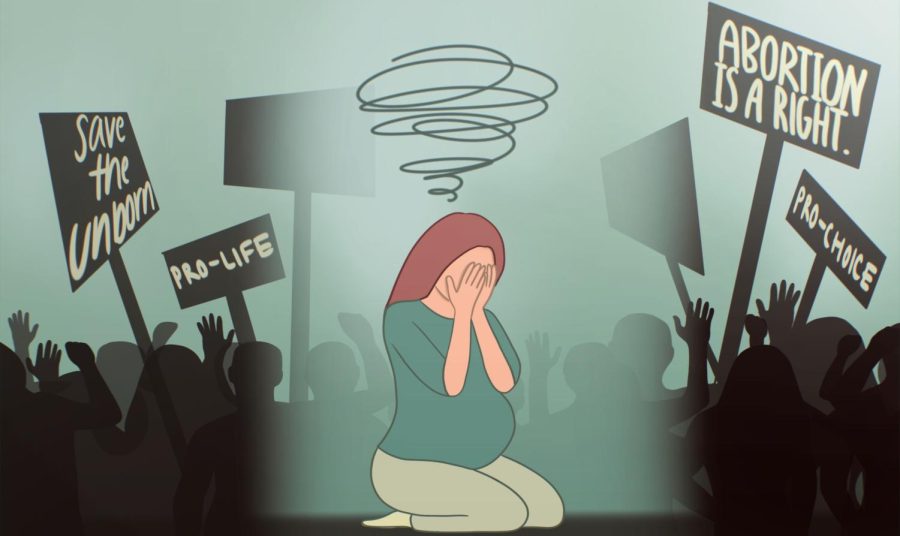Pro-nuance: More than just a label
Abortion opinions can fall between pro-choice and pro-life
On nuanced issues such as abortion, labelling people one of two ways is more harmful than helpful, because it implies so many unsaid words.
March 26, 2022
The first time I “officially declared” my stance on abortion was in the pages of the Winged Post in the second semester of my sophomore year. Before that, I had mentioned it in casual conversation when the topic came up, but those little mentions were insignificant compared to the permanence of my words in the physical pages of a newspaper distributed to the school.
When a reporter for that Winged Post piece first reached out for an interview, I was 100% sure about my stance. Back then, abortion was still a black and white issue to me. The only uncertainty I had was whether or not to make my voice heard in the paper. I remember talking to my parents the night before I agreed to the interview, trying to decide whether or not to immortalize my stance in ink. I had certainty in my opinion, but overwhelming uncertainty about potential backlash from my peers and community. Even then, I recognized that there were strong (negative) connotations to both my stance and relevant aspects of my identity: being pro-life and being Christian.
When the paper came out, it stated that 85% of 173 upper school student respondents identified as pro-choice as of Nov. 10, 2019, as opposed to 1.2% who identified as pro-life. Looking back at it now, I’ve realized that only one other person in the school who responded to the poll also identified as pro-life.
Upon reflection, my unwavering stance likely arose from how I first encountered the issue of abortion. It wasn’t a topic I had heard much about when I was younger, and so the few instances when it was really discussed in depth stick out to me. My first conscious memory of learning about abortion was in sixth grade, when my youth pastor invited a volunteer from Planned Parenthood to speak. She spoke about abortions she had undergone when she was younger, her struggle with religion during that time and how much she regretted her abortions now. Throughout the night, I remembered bits and pieces of the more interactive parts of her visit, including passing a figure of a fetus at the actual size it would be at six weeks around the room for everyone to see and hold.
As a result of that night, I internalized the stance that I still hold now. The stance that, as a Christian, I believe that all life is precious and that the right to live should never be infringed upon.
I have always been pro-life. But I don’t think I ever fully believed that people should be forced to choose life in all cases. In middle school, whenever I thought about my stance, I would come up with elaborate laws in my head to greatly limit but not completely outlaw abortion. One such “law” went along the lines of “besides cases of rape and incest, abortions should only be allowed if couples can provide evidence that birth control was used but the pregnancy occurred anyway.” My nuanced “laws” were completely infeasible and ridiculous, but they made me feel better about my opinion on the matter, making abortions accessible only in situations where I couldn’t cast blame on the couple involved.
Besides making up justifications in my head, I would also read different Christian articles about abortion to try to find one that “clicked” and guide my own perspective. But I also watched videos and read articles in an effort to also find a non-religious reason for my opinion.
Despite all the back and forth in my mind, I never found the need to flesh out the exact nuances of my thoughts until I had a long argument with a friend about abortion one night over text. In truth, by that point in my life, I had realized that I didn’t think the government should be able to make laws restricting the legality of abortion. But that didn’t negate the other aspects of my pro-life stance. I still believed in pro-life, only changing how I thought change should be addressed — through increased resources and education and advocating against going through with an abortion rather than enacting laws against it.
After that discussion was when I first began to truly reflect upon not only my stance on abortion, but also the technicality of the terms involved.
Merriam Webster defines pro-life as “opposed to abortion.”
I agree. In principle, I don’t agree with abortion in any situation.
Merriam Webster defines pro-choice as “favoring the legalization of abortion.
I find myself also in agreement with this statement. Despite my disagreement with abortion as a concept, I also believe that the government should not be able to control whether or not a woman chooses to abort her baby. In every situation, I would advocate against abortion and I would never get one myself, but I do understand that different women make different choices in different situations. It took me a long time to understand that the stand I take does not have to align with what I would personally do in a situation.
Although I morally agree with pro-life and reluctantly recognize that upon technicality I agree with pro-choice, when asked, I still choose to identify myself as pro-life before elaborating on my stance because of the connotations of both sides. I can’t say I completely understand why, but I would rather someone first judge me and assume I’m against women’s reproductive rights than for them to assume that I’m okay with the concept of abortion.
Thus, on nuanced issues such as abortion, labelling people one of two ways is more harmful than helpful because it implies so many unsaid words. Without diving further into conversation with each individual, it is impossible to determine where they lie on the spectrum. And without learning their unique perspectives, hearing a one-term label steers people to assume the extremes of each view.




![LALC Vice President of External Affairs Raeanne Li (11) explains the International Phonetic Alphabet to attendees. "We decided to have more fun topics this year instead of just talking about the same things every year so our older members can also [enjoy],” Raeanne said.](https://harkeraquila.com/wp-content/uploads/2025/10/DSC_4627-1200x795.jpg)


















![“[Building nerf blasters] became this outlet of creativity for me that hasn't been matched by anything else. The process [of] making a build complete to your desire is such a painstakingly difficult process, but I've had to learn from [the skills needed from] soldering to proper painting. There's so many different options for everything, if you think about it, it exists. The best part is [that] if it doesn't exist, you can build it yourself," Ishaan Parate said.](https://harkeraquila.com/wp-content/uploads/2022/08/DSC_8149-900x604.jpg)




![“When I came into high school, I was ready to be a follower. But DECA was a game changer for me. It helped me overcome my fear of public speaking, and it's played such a major role in who I've become today. To be able to successfully lead a chapter of 150 students, an officer team and be one of the upperclassmen I once really admired is something I'm [really] proud of,” Anvitha Tummala ('21) said.](https://harkeraquila.com/wp-content/uploads/2021/07/Screen-Shot-2021-07-25-at-9.50.05-AM-900x594.png)







![“I think getting up in the morning and having a sense of purpose [is exciting]. I think without a certain amount of drive, life is kind of obsolete and mundane, and I think having that every single day is what makes each day unique and kind of makes life exciting,” Neymika Jain (12) said.](https://harkeraquila.com/wp-content/uploads/2017/06/Screen-Shot-2017-06-03-at-4.54.16-PM.png)








![“My slogan is ‘slow feet, don’t eat, and I’m hungry.’ You need to run fast to get where you are–you aren't going to get those championships if you aren't fast,” Angel Cervantes (12) said. “I want to do well in school on my tests and in track and win championships for my team. I live by that, [and] I can do that anywhere: in the classroom or on the field.”](https://harkeraquila.com/wp-content/uploads/2018/06/DSC5146-900x601.jpg)
![“[Volleyball has] taught me how to fall correctly, and another thing it taught is that you don’t have to be the best at something to be good at it. If you just hit the ball in a smart way, then it still scores points and you’re good at it. You could be a background player and still make a much bigger impact on the team than you would think,” Anya Gert (’20) said.](https://harkeraquila.com/wp-content/uploads/2020/06/AnnaGert_JinTuan_HoHPhotoEdited-600x900.jpeg)

![“I'm not nearly there yet, but [my confidence has] definitely been getting better since I was pretty shy and timid coming into Harker my freshman year. I know that there's a lot of people that are really confident in what they do, and I really admire them. Everyone's so driven and that has really pushed me to kind of try to find my own place in high school and be more confident,” Alyssa Huang (’20) said.](https://harkeraquila.com/wp-content/uploads/2020/06/AlyssaHuang_EmilyChen_HoHPhoto-900x749.jpeg)










